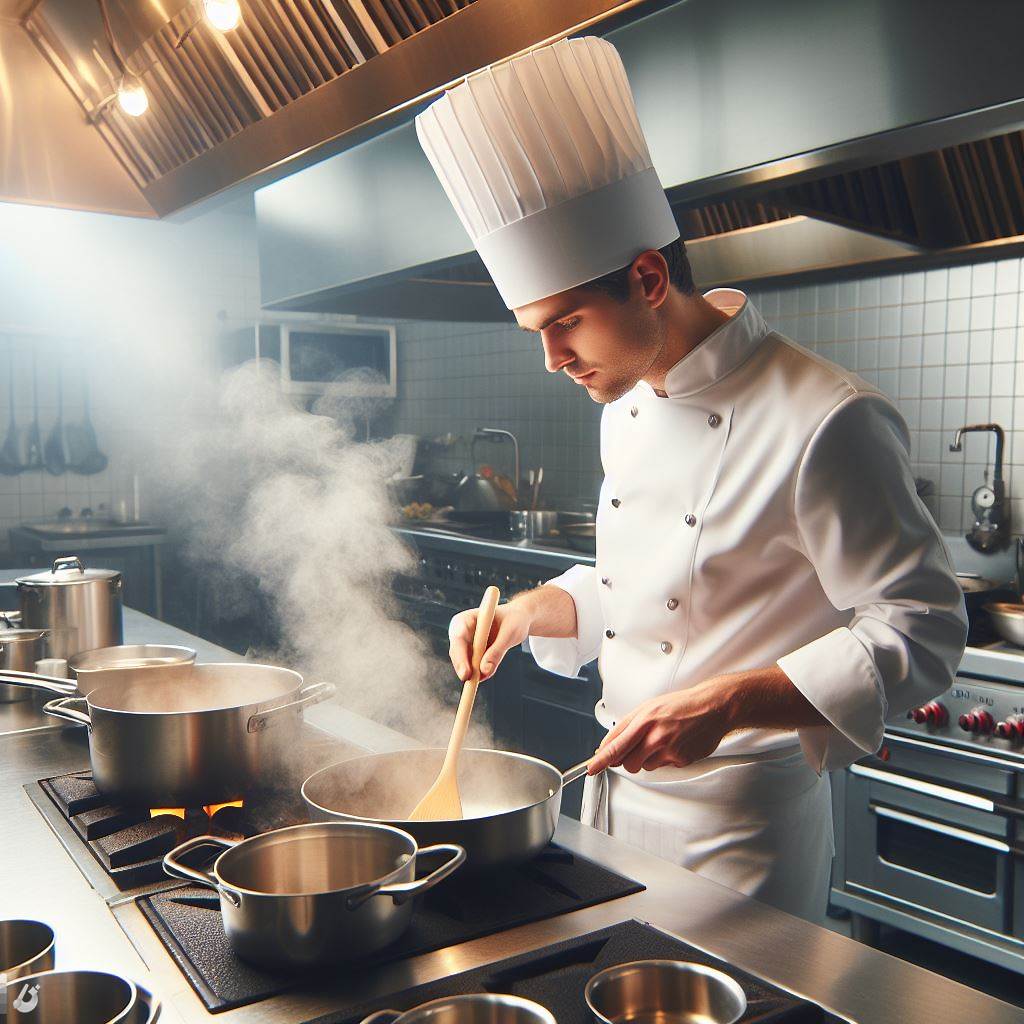Introduction
In UK kitchens, ensuring health and safety measures are in place is of utmost importance.
Not only does it protect the well-being of staff, but also safeguards the customers who consume the food prepared in these kitchens.
This blog post is designed to serve as a guide for individuals working in UK kitchens, providing valuable information on best practices and regulations to ensure a safe and healthy working environment.
By following the guidelines outlined in this post, kitchen staff can minimize the risk of accidents, injuries, and the spread of foodborne illnesses.
The structure of this blog post will consist of various sections that cover different aspects of health and safety in UK kitchens.
Each section will focus on a specific area such as personal hygiene, equipment maintenance, cleaning procedures, and fire safety.
By highlighting the purpose and structure of this blog post, readers will understand what to expect and how to navigate through the content effectively.
This ensures that the information provided is easily accessible and applicable to their specific kitchen environment.
In short, prioritizing health and safety in UK kitchens is vital for the well-being of both staff and customers.
This blog post serves as a comprehensive guide, addressing various aspects of health and safety practices in an organized manner.
By following the guidelines provided, individuals can create a safe and healthy working environment in their UK kitchens.
Importance of Health and Safety in UK Kitchens
In order to ensure the well-being of both kitchen staff and customers, it is crucial to prioritize health and safety in UK kitchens.
Discussion on the potential hazards in kitchens
- Poor hygiene practices can lead to food contamination and the spread of bacteria.
- Slippery floors, hot surfaces, and sharp knives are common physical hazards in kitchens.
- Improper storage of chemicals and flammable materials can pose a risk of accidents and fires.
- Inadequate ventilation can result in the accumulation of harmful fumes and smoke.
- Insufficient training and lack of awareness about safety procedures contribute to potential hazards.
To mitigate these risks, it is necessary to identify potential hazards and take appropriate measures to prevent accidents and ensure a safe working environment.
Explanation of the potential consequences of not following health and safety guidelines
- Failure to comply with health and safety regulations can lead to legal consequences and penalties.
- Poor health and safety practices can result in foodborne illnesses, causing harm to customers.
- Accidents in the kitchen can cause injuries, resulting in physical pain and financial loss for individuals.
- Negative publicity and damage to reputation can occur if health and safety breaches are exposed.
- A lack of trust and confidence among staff can arise, leading to decreased productivity and morale.
By following health and safety guidelines, kitchen owners can protect their reputation, ensure customer satisfaction, and prevent potential legal issues.
Prioritizing the well-being and safety of staff leads to a more efficient and positive working environment.
Personalized UK Career Consulting
Receive tailored career guidance designed just for you. Get actionable steps and expert support to boost your career in 1-3 days. Take control of your career now.
Get StartedIntroduction of the legal responsibilities and obligations of kitchen owners and staff
In the UK, kitchen owners and staff have legal responsibilities and obligations to uphold health and safety standards.
These include:
- Creating a safe and hygienic work environment by implementing necessary measures and practices.
- Providing appropriate training to staff on health and safety protocols and procedures.
- Regularly inspecting the premises for potential hazards and taking prompt actions to address them.
- Keeping records of health and safety inspections, incidents, and staff training.
- Complying with relevant legislation, such as the Health and Safety at Work Act 1974.
Failure to fulfill these legal responsibilities can lead to legal consequences and compromise the safety of both staff and customers.
In fact, the significance of health and safety in UK kitchens cannot be overstated.
By recognizing potential hazards, understanding the consequences of non-compliance, and fulfilling legal responsibilities, kitchen owners can create a safe environment that promotes the well-being of everyone involved.
Read: The Evolution of British Cuisine by Chefs
Key Health and Safety Guidelines in UK Kitchens
In order to maintain a safe and healthy kitchen environment in the UK, it is essential to follow key health and safety guidelines.
These guidelines cover various aspects of kitchen operations, from personal hygiene practices to preventing accidents and emergencies.
Personal hygiene practices
Personal hygiene practices play a crucial role in ensuring food safety.
Handwashing procedures should be followed diligently to prevent the spread of harmful bacteria and viruses.
It is important for kitchen staff to be aware of food allergies and contamination risks.
This includes understanding ingredient labels and preventing cross-contamination during food preparation.
Safe food handling and storage
Safe food handling and storage is another vital aspect of kitchen health and safety.
Temperature control principles should be implemented to prevent the growth of bacteria in perishable foods.
Your Dream Job Starts with a Perfect CV
Get a tailored CV and cover letter that captures your unique strengths and stands out in your industry. Let us help you make an unforgettable first impression.
Get StartedProper labeling and rotation of food items based on the FIFO principle help maintain food quality and reduce the risk of foodborne illnesses.
Equipment safety measures
The maintenance and cleaning of kitchen appliances are necessary to ensure equipment safety.
Regular inspections and cleaning routines help identify any potential hazards or malfunctions.
Following the instructions for the safe operation of appliances and tools minimizes the risk of accidents and injuries.
Fire safety and emergency procedures
Fire safety is a critical concern in any kitchen environment.
Installing fire detection systems and having fire extinguishers readily available can help prevent and manage fire incidents.
Proper staff training on fire prevention and knowledge of emergency evacuation plans are essential to ensure the safety of all individuals in the kitchen.
Preventing slips, trips, and falls
Preventing slips, trips, and falls is crucial in maintaining a safe working environment.
This can be achieved by ensuring clear walkways free of obstacles and using appropriate flooring materials with anti-slip properties.
The proper use of floor cleaning materials and displaying warning signs during cleaning activities also contribute to preventing accidents.
Overall, adhering to these key health and safety guidelines in UK kitchens is essential for preserving the well-being of both kitchen staff and customers.
By practicing personal hygiene, safe food handling, equipment maintenance, fire safety, and accident prevention measures, a kitchen can operate efficiently while prioritizing health and safety.
Read: Vegan Chefs Revolutionizing UK Cuisine

Training and Certification for Kitchen Staff
Providing proper training and certification to kitchen staff is crucial for maintaining health and safety standards in any food service establishment.
Optimize Your LinkedIn for Success
Boost your LinkedIn profile with a professional bio, keyword-rich headline, and strategic recommendations that attract recruiters. Stand out from the crowd and get noticed.
Optimize NowIn the fast-paced and demanding environment of a kitchen, where potential hazards are present, trained staff can play a vital role in preventing accidents, ensuring food safety, and responding effectively to emergencies.
Overview of the relevant health and safety courses and certifications available
The range of health and safety courses and certifications available is diverse, covering various aspects of kitchen operations.
One of the fundamental requirements is the Food Hygiene Certificate, which equips staff with the necessary knowledge of safe food handling practices to prevent food contamination and the spread of foodborne illnesses.
In addition to food hygiene, it is crucial to provide First Aid Training to kitchen staff.
This equips them with essential skills to respond promptly and effectively in case of accidents or injuries, thus minimizing the severity of potential harm.
Moreover, Fire Safety Training is necessary to raise awareness regarding fire prevention measures, emergency evacuation procedures, and the use of fire-fighting equipment.
Manual Handling Training is also significant as it educates employees on proper lifting and carrying techniques, reducing the risk of musculoskeletal injuries.
This training promotes safe handling practices to protect employees from strains, sprains, and other physical ailments that can result from repetitive activities or incorrect lifting methods.
Discussion on the benefits of providing training to kitchen staff
Providing training to kitchen staff offers several benefits to both individuals and establishments as a whole.
By enhancing workforce safety, such training programs create a secure environment and reduce the likelihood of accidents or injuries.
Establishments that prioritize training also ensure compliance with health and safety regulations, safeguarding their reputation and avoiding potential legal issues.
In addition to safety considerations, training enhances the efficiency of kitchen staff by improving their skills and knowledge of best practices.
With proper training, employees can work with confidence and competence, leading to increased productivity and improved quality of service.
Consequently, this can positively impact customer satisfaction and the reputation of the establishment.
Investing in training can result in cost savings for establishments.
By minimizing accidents, injuries, and foodborne illnesses through proper training, organizations can reduce expenses related to medical treatment, compensation, legal actions, and reputation damage control.
Examples of industry-recognized health and safety training programs
Several industry-recognized training programs are available to meet the specific health and safety needs of kitchen staff.
For example, the Chartered Institute of Environmental Health (CIEH) offers courses such as Level 2 Food Safety, Health and Safety in the Workplace, and more.
The National Examination Board in Occupational Safety and Health (NEBOSH) provides certifications like the NEBOSH General Certificate in Occupational Health and Safety.
The Royal Society for Public Health (RSPH) also offers qualifications including the Level 2 Award in Food Safety and Hygiene for Catering.
First Aid Awards Ltd. (FAA) specializes in First Aid at Work qualifications and related training programs, equipping kitchen staff with crucial life-saving skills.
In essence, training and certification play a vital role in promoting health and safety in UK kitchens.
By investing in comprehensive training programs and ensuring staff members acquire relevant certifications, establishments can enhance workforce safety, comply with regulations, improve efficiency, and ultimately provide a safe and high-quality dining experience for their customers.
Read: Sustainability: A New Focus for UK Chefs
Maintaining Health and Safety Standards in UK Kitchens
Importance of regular inspections and risk assessments
Regular inspections and risk assessments are crucial in ensuring the maintenance of health and safety standards in UK kitchens.
Firstly, inspections can identify potential hazards or risks that may compromise the well-being of kitchen staff and customers.
Secondly, conducting regular risk assessments allows for the identification and evaluation of potential risks, which helps determine appropriate control measures to be implemented.
Inspections and risk assessments demonstrate a commitment to the safety and well-being of all individuals within the kitchen environment.
Strategies for implementing and promoting a culture of safety in the workplace
To implement and promote a culture of safety in the workplace, organizations can adopt the following strategies:
- Develop comprehensive health and safety policies and procedures that are regularly reviewed and updated.
- Provide adequate training and resources to ensure that all staff members understand and adhere to health and safety guidelines.
- Encourage employees to actively participate in safety initiatives and provide feedback on potential hazards or improvements.
- Recognize and reward individuals and teams that demonstrate a commitment to health and safety in the kitchen.
By implementing these strategies, organizations can create a culture where safety is valued, leading to fewer accidents and improved overall well-being.
The role of management in enforcing health and safety guidelines
Management plays a significant role in enforcing health and safety guidelines in UK kitchens.
Firstly, management must lead by example, demonstrating their commitment to health and safety through their actions and decisions.
Secondly, it is crucial for managers to provide clear communication regarding health and safety expectations and policies.
Managers also have the responsibility to ensure that appropriate resources, such as adequate staffing and safety equipment, are available to employees.
Management should regularly review and evaluate the effectiveness of health and safety measures, making necessary adjustments and improvements when required.
By actively enforcing health and safety guidelines, management sets the foundation for a safe working environment.
Encouraging open communication and reporting of incidents or concerns
Encouraging open communication and reporting of incidents or concerns is vital for maintaining health and safety standards in UK kitchens.
Creating a non-punitive environment where employees feel comfortable reporting incidents or raising concerns is essential.
Organizations should establish clear reporting procedures and provide channels for anonymous reporting to ensure confidentiality.
Furthermore, regular communication and feedback sessions with staff can help identify potential issues and address them promptly.
By encouraging open communication and reporting, organizations can identify and mitigate risks, ultimately fostering a safer kitchen environment.
Maintaining health and safety standards in UK kitchens requires regular inspections and risk assessments, strategies for promoting a culture of safety, management enforcement of guidelines, and encouragement of open communication and reporting.
By prioritizing and investing in these areas, organizations can create a safe and secure environment for both employees and customers.
Read: Famous UK Chefs: Stories of Culinary Success
Conclusion
Throughout this blog post, we have covered various crucial aspects of health and safety in UK kitchens.
We started by emphasizing the importance of proper hygiene practices, including regular handwashing and cleaning of kitchen surfaces.
We also highlighted the significance of maintaining food safety, such as storing perishable items correctly and avoiding cross-contamination.
Furthermore, we addressed the need for proper kitchen ventilation to minimize exposure to harmful fumes and maintain good air quality.
We touched upon the importance of using appropriate personal protective equipment to protect oneself from potential hazards.
Ensuring health and safety in UK kitchens is not just a legal requirement but also a moral obligation.
By prioritizing these measures, we safeguard the well-being of ourselves, our families, and the wider community.
Each individual’s commitment to maintaining a safe kitchen environment contributes to a healthier society as a whole.
As you conclude reading this blog section, we urge you to reflect on the key points discussed and take action in your own kitchen.
Implementing proper hygiene practices, observing food safety guidelines, ensuring good ventilation, and wearing appropriate protective gear are small yet significant steps towards creating a safer kitchen environment.
Together, let’s embrace the value of health and safety in our daily lives and promote a culture of well-being for everyone involved in the kitchen.
Remember, it is in our hands to protect ourselves and those around us.
[E-Book for Sale]
500 Cutting-Edge Tech Startup Ideas for 2024 & 2025: Innovate, Create, Dominate
$19.99 • 500 Tech Startup Ideas • 62 pages
You will get inspired with 500 innovative tech startup ideas for 2024 and 2025, complete with concise descriptions to help you kickstart your entrepreneurial journey in AI, Blockchain, IoT, Fintech, and AR/VR.




